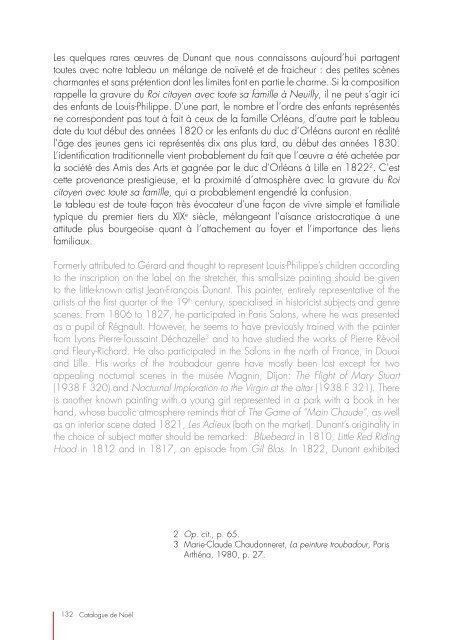Create successful ePaper yourself
Turn your PDF publications into a flip-book with our unique Google optimized e-Paper software.
Les quelques rares œuvres <strong>de</strong> Dunant que nous connaissons aujourd’hui partagent<br />
toutes avec notre tableau un mélange <strong>de</strong> naïveté et <strong>de</strong> fraicheur : <strong>de</strong>s petites scènes<br />
charmantes et sans prétention dont les limites font en partie le charme. Si la composition<br />
rappelle la gravure du Roi citoyen avec toute sa famille à Neuilly, il ne peut s’agir ici<br />
<strong>de</strong>s enfants <strong>de</strong> Louis-Philippe. D’une part, le nombre et l’ordre <strong>de</strong>s enfants représentés<br />
ne correspon<strong>de</strong>nt pas tout à fait à ceux <strong>de</strong> la famille Orléans, d’autre part le tableau<br />
date du tout <strong>de</strong>́but <strong>de</strong>s années 1820 or les enfants du duc d’Orléans auront en réalité<br />
l’âge <strong>de</strong>s jeunes gens ici représentés dix ans plus tard, au <strong>de</strong>́but <strong>de</strong>s années 1830.<br />
L’i<strong>de</strong>ntification traditionnelle vient probablement du fait que l’œuvre a été achetée par<br />
la société <strong>de</strong>s Amis <strong>de</strong>s Arts et gagnée par le duc d’Orléans à Lille en 1822 2 . C’est<br />
cette provenance prestigieuse, et la proximité d’atmosphère avec la gravure du Roi<br />
citoyen avec toute sa famille, qui a probablement engendré la confusion.<br />
Le tableau est <strong>de</strong> toute façon très évocateur d’une façon <strong>de</strong> vivre simple et familiale<br />
typique du premier tiers du XIX e siècle, mélangeant l’aisance aristocratique à une<br />
attitu<strong>de</strong> plus bourgeoise quant à l’attachement au foyer et l’importance <strong>de</strong>s liens<br />
familiaux.<br />
Formerly attributed to Gérard and thought to represent Louis-Philippe’s children according<br />
to the inscription on the label on the stretcher, this small-size painting should be given<br />
to the little-known artist Jean-François Dunant. This painter, entirely representative of the<br />
artists of the first quarter of the 19 th century, specialised in historicist subjects and genre<br />
scenes. From 1806 to 1827, he participated in Paris Salons, where he was presented<br />
as a pupil of Régnault. However, he seems to have previously trained with the painter<br />
from Lyons Pierre-Toussaint Déchazelle 3 and to have studied the works of Pierre Révoil<br />
and Fleury-Richard. He also participated in the Salons in the north of France, in Douai<br />
and Lille. His works of the troubadour genre have mostly been lost except for two<br />
appealing nocturnal scenes in the musée Magnin, Dijon: The Flight of Mary Stuart<br />
(1938 F 320) and Nocturnal Imploration to the Virgin at the altar (1938 F 321). There<br />
is another known painting with a young girl represented in a park with a book in her<br />
hand, whose bucolic atmosphere reminds that of The Game of “Main Chau<strong>de</strong>”, as well<br />
as an interior scene dated 1821, Les Adieux (both on the market). Dunant’s originality in<br />
the choice of subject matter should be remarked: Bluebeard in 1810, Little Red Riding<br />
Hood in 1812 and in 1817, an episo<strong>de</strong> from Gil Blas. In 1822, Dunant exhibited<br />
2 Op. cit., p. 65.<br />
3 Marie-Clau<strong>de</strong> Chaudonneret, La peinture troubadour, Paris<br />
Arthéna, 1980, p. 27.<br />
132<br />
<strong>Catalogue</strong> <strong>de</strong> Noël
















